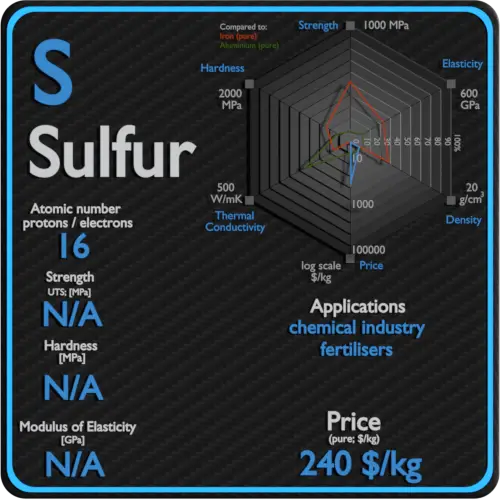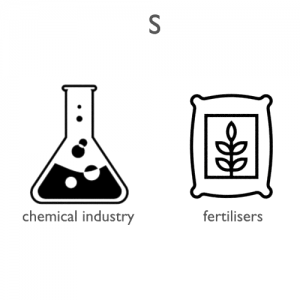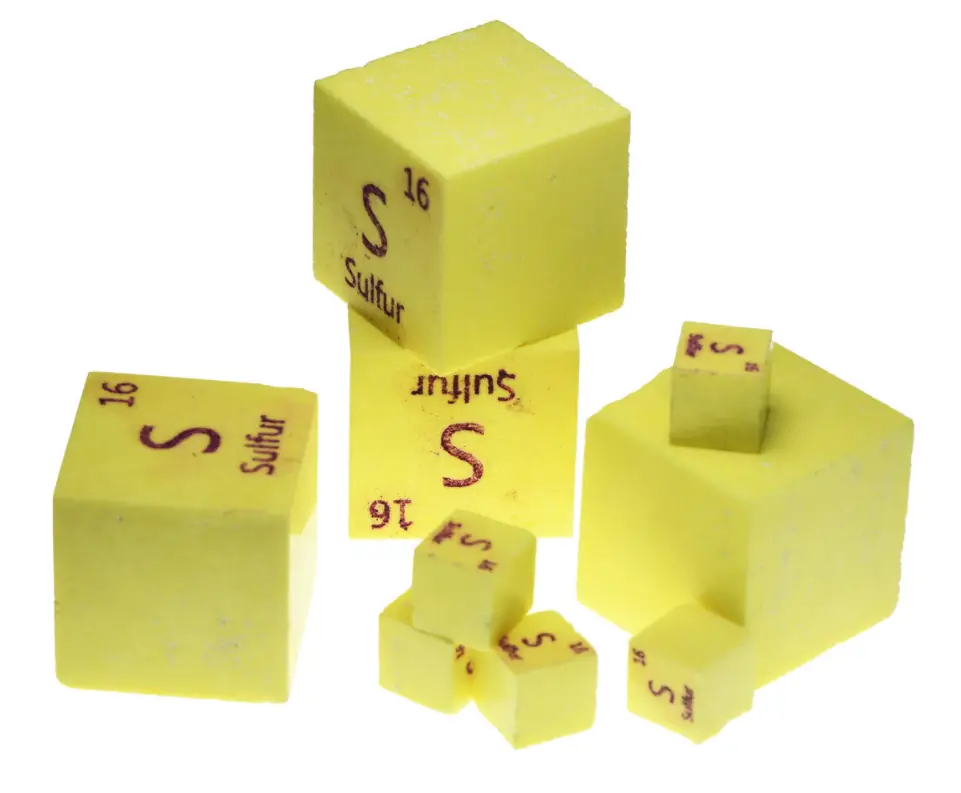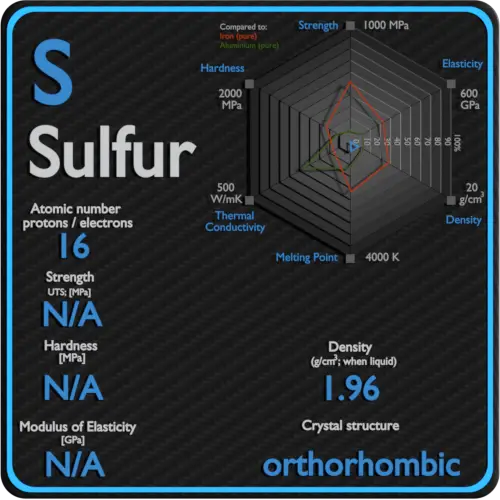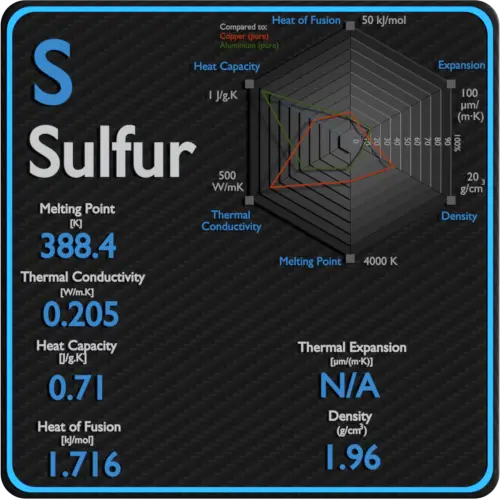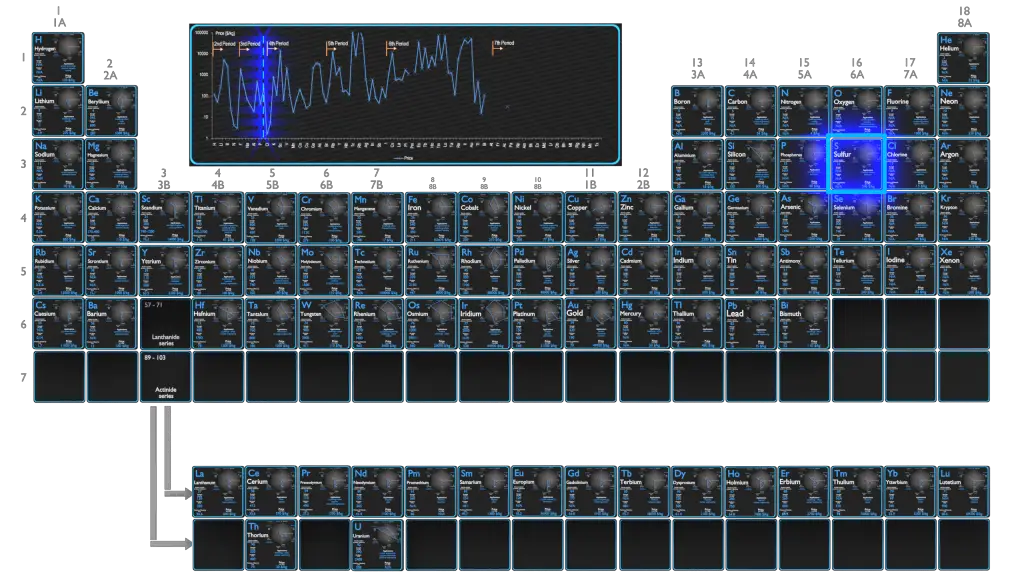About Sulfur
Sulfur is abundant, multivalent, and nonmetallic. Under normal conditions, sulfur atoms form cyclic octatomic molecules with a chemical formula S8. Elemental sulfur is a bright yellow crystalline solid at room temperature. Chemically, sulfur reacts with all elements except for gold, platinum, iridium, tellurium, and the noble gases.
Summary
| Element | Sulfur |
| Atomic number | 16 |
| Element category | Non Metal |
| Phase at STP | Solid |
| Density | 1.96 g/cm3 |
| Ultimate Tensile Strength | N/A |
| Yield Strength | N/A |
| Young’s Modulus of Elasticity | N/A |
| Mohs Scale | 2 |
| Brinell Hardness | N/A |
| Vickers Hardness | N/A |
| Melting Point | 112.8 °C |
| Boiling Point | 444.7 °C |
| Thermal Conductivity | 0.269 W/mK |
| Thermal Expansion Coefficient | — µm/mK |
| Specific Heat | 0.71 J/g K |
| Heat of Fusion | 1.7175 kJ/mol |
| Heat of Vaporization | 45 kJ/mol |
| Electrical resistivity [nanoOhm meter] | 2E24 |
| Magnetic Susceptibility | −15.5e-6 cm^3/mol |
Applications of Sulfur
The greatest commercial use of the element is the production of sulfuric acid for sulfate and phosphate fertilizers, and other chemical processes. Sulfur is increasingly used as a component of fertilizers. The most important form of sulfur for fertilizer is the mineral calcium sulfate. The element sulfur is used in matches, insecticides, and fungicides. Many sulfur compounds are odoriferous, and the smells of odorized natural gas, skunk scent, grapefruit, and garlic are due to organosulfur compounds.
Production and Price of Sulfur
Raw materials prices change daily. They are primarily driven by supply, demand and energy prices. In 2019, prices of pure Sulfur were at around 240 $/kg.
Production of Sulphur carried out in three basic ways. It can be mined through the use of wells drilled to sulphur deposits and worked with the “Frasch” method. It can be extracted from the oil or gas stream at a processing plant. And it can be scraped from the surface of the earth or dug out of open pits. “Crude” sulfur is produced from the Frasch process or recovered from “sour” natural gas or petroleum. Although termed “crude”, this sulfur possesses a minimum purity of 99.5 percent and is suitable for a majority of uses. The impurities consist primarily of trapped organic matter. Today, almost all elemental sulfur is produced as a byproduct of removing sulfur-containing contaminants from natural gas and petroleum.
Source: www.luciteria.com
Mechanical Properties of Sulfur
Strength of Sulfur
In mechanics of materials, the strength of a material is its ability to withstand an applied load without failure or plastic deformation. Strength of materials basically considers the relationship between the external loads applied to a material and the resulting deformation or change in material dimensions. In designing structures and machines, it is important to consider these factors, in order that the material selected will have adequate strength to resist applied loads or forces and retain its original shape. Strength of a material is its ability to withstand this applied load without failure or plastic deformation.
For tensile stress, the capacity of a material or structure to withstand loads tending to elongate is known as ultimate tensile strength (UTS). Yield strength or yield stress is the material property defined as the stress at which a material begins to deform plastically whereas yield point is the point where nonlinear (elastic + plastic) deformation begins.
See also: Strength of Materials
Ultimate Tensile Strength of Sulfur
Ultimate tensile strength of Sulfur is N/A.
Yield Strength of Sulfur
Yield strength of Sulfur is N/A.
Modulus of Elasticity of Sulfur
The Young’s modulus of elasticity of Sulfur is N/A.
Hardness of Sulfur
In materials science, hardness is the ability to withstand surface indentation (localized plastic deformation) and scratching. Brinell hardness test is one of indentation hardness tests, that has been developed for hardness testing. In Brinell tests, a hard, spherical indenter is forced under a specific load into the surface of the metal to be tested.
Brinell hardness of Sulfur is approximately N/A.
The Vickers hardness test method was developed by Robert L. Smith and George E. Sandland at Vickers Ltd as an alternative to the Brinell method to measure the hardness of materials. The Vickers hardness test method can be also used as a microhardness test method, which is mostly used for small parts, thin sections, or case depth work.
Vickers hardness of Sulfur is approximately N/A.
Scratch hardness is the measure of how resistant a sample is to permanent plastic deformation due to friction from a sharp object. The most common scale for this qualitative test is Mohs scale, which is used in mineralogy. The Mohs scale of mineral hardness is based on the ability of one natural sample of mineral to scratch another mineral visibly.
Sulfur is has a hardness of approximately 2.
See also: Hardness of Materials
Sulfur – Crystal Structure
A possible crystal structure of Sulfur is orthorombic structure.
In metals, and in many other solids, the atoms are arranged in regular arrays called crystals. A crystal lattice is a repeating pattern of mathematical points that extends throughout space. The forces of chemical bonding causes this repetition. It is this repeated pattern which control properties like strength, ductility, density, conductivity (property of conducting or transmitting heat, electricity, etc.), and shape. There are 14 general types of such patterns known as Bravais lattices.
See also: Crystal Structure of Materials
Crystal Structure of Sulfur

Thermal Properties of Sulfur
Sulfur – Melting Point and Boiling Point
Melting point of Sulfur is 112.8°C.
Boiling point of Sulfur is 444.7°C.
Note that, these points are associated with the standard atmospheric pressure.
Sulfur – Thermal Conductivity
Thermal conductivity of Sulfur is 0.269 W/(m·K).
The heat transfer characteristics of a solid material are measured by a property called the thermal conductivity, k (or λ), measured in W/m.K. It is a measure of a substance’s ability to transfer heat through a material by conduction. Note that Fourier’s law applies for all matter, regardless of its state (solid, liquid, or gas), therefore, it is also defined for liquids and gases.
Coefficient of Thermal Expansion of Sulfur
Linear thermal expansion coefficient of Sulfur is — µm/(m·K)
Thermal expansion is generally the tendency of matter to change its dimensions in response to a change in temperature. It is usually expressed as a fractional change in length or volume per unit temperature change.
Sulfur – Specific Heat, Latent Heat of Fusion, Latent Heat of Vaporization
Specific heat of Sulfur is 0.71 J/g K.
Heat capacity is an extensive property of matter, meaning it is proportional to the size of the system. Heat capacity C has the unit of energy per degree or energy per kelvin. When expressing the same phenomenon as an intensive property, the heat capacity is divided by the amount of substance, mass, or volume, thus the quantity is independent of the size or extent of the sample.
Latent Heat of Fusion of Sulfur is 1.7175 kJ/mol.
Latent Heat of Vaporization of Sulfur is 45 kJ/mol.
Latent heat is the amount of heat added to or removed from a substance to produce a change in phase. This energy breaks down the intermolecular attractive forces, and also must provide the energy necessary to expand the gas (the pΔV work). When latent heat is added, no temperature change occurs. The enthalpy of vaporization is a function of the pressure at which that transformation takes place.
Sulfur – Electrical Resistivity – Magnetic Susceptibility
Electrical property refers to the response of a material to an applied electric field. One of the principal characteristics of materials is their ability (or lack of ability) to conduct electrical current. Indeed, materials are classified by this property, that is, they are divided into conductors, semiconductors, and nonconductors.
See also: Electrical Properties
Magnetic property refers to the response of a material to an applied magnetic field. The macroscopic magnetic properties of a material are a consequence of interactions between an external magnetic field and the magnetic dipole moments of the constituent atoms. Different materials react to the application of magnetic field differently.
See also: Magnetic Properties
Electrical Resistivity of Sulfur
Electrical resistivity of Sulfur is 2E24 nΩ⋅m.
Electrical conductivity and its converse, electrical resistivity, is a fundamental property of a material that quantifies how Sulfur conducts the flow of electric current. Electrical conductivity or specific conductance is the reciprocal of electrical resistivity.
Magnetic Susceptibility of Sulfur
Magnetic susceptibility of Sulfur is −15.5e-6 cm^3/mol.
In electromagnetism, magnetic susceptibility is the measure of the magnetization of a substance. Magnetic susceptibility is a dimensionless proportionality factor that indicates the degree of magnetization of Sulfur in response to an applied magnetic field.
